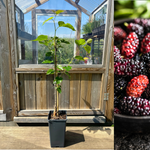Subscribe and save 10%!

Dwarf Mulberry Mojo Berry® 'Matsunaga' 60-80 cm (Morus rotundiloba)
372 SEK
Unit price perExpected delivery date: 08 December to 15 December.
Applies to orders within Sweden. For other countries - see our delivery terms .
In stock - Ready to be shipped
Share
372 SEK
Unit price per1 Dwarf Mulberry Mojo Berry® 'Matsunaga': current height 60-80 cm
The picture is just an example, this batch of plants is taller and stronger.
Common name: Dwarf Mulberry, Mojo Berry ®
Scientific name: Morus rotundiloba
Family: Moraceae
Plant history & use:
Mojo Berry® is a short-growing mulberry variety that bears fruit on both older and new branches, which means you can pick mulberries in the first year, unlike the usual 5 or 6 years that it takes most other mulberries.
This dwarf, compact variety only reaches a height of around 1.5 m (compared to regular mulberries which can grow up to 6-8 m tall), making it suitable for any garden.
Unlike other varieties that only produce fruit during a 3-week period towards the end of summer, Mojo Berry® produces berries over a very long period, from May right through to September.
The fruits are great for using in jam, cake or other dishes.
Mojo Berry® is beautiful as a solitary tree in a pot on the terrace/patio or in a pot with co-planting together with other plants and is also nice as a hedge plant/border.
General information about Mulberry:
Mulberry trees are one of our oldest cultivated plants. The black mulberry tree, like the white variety, Morus alba , originates from West Asia - however, the black mulberry tree came to Europe a couple of hundred years before the white one. The first findings of knowledge about the black mulberry tree were already around 300 BC. It may be that Morus nigra originates somewhat further to the southwest (closer to Europe) in West Asia than its relative Morus alba, and that this is why Morus nigra also has a slightly worse hardiness in cold climates than its relative.
Traditionally, the black mulberry was used to make wine and cosmetics - thanks to its high concentration of anthocyanins which give the berry its deep dark colour. However, the berries were also grown for fresh consumption.
Unlike the white mulberry tree, which can vary in color, the black mulberry tree's fruits are always black when ripe. The black mulberry is also more acidic.
The berries are rich in antioxidants and, like mulberry leaf tea, are thought to help balance blood sugar levels. This is thanks to content of the substance MFE which stabilizes blood sugar levels and thus suppresses the body's cravings for sweets. Therefore, mulberries are a common substitute for those who want to get rid of their cravings for sweets.
Due to the berries' unusually high nutritional content, mulberries, like the goji berry , are considered a so-called "superfood".
In addition to mulberry wine, you can also make juice and jam from the berries.
The leaves can be used to brew healthy tea, which has historically been drunk in China and has recently begun to become popular in Asia again.
Culture:
Mojo Berry® is hardy down to -10 ° C = outdoor cultivation zone 1-2 . If you cover the tree with sheep wool or similar for the winter, it can survive outdoors up to zone 5. Alternatively, grow in a pot and place in a greenhouse/storage over the winter.
The tree can grow in most soils but thrives best in loose, nutrient-rich soils. It is resistant to windy coastal climates but grows best in warm, wind-sheltered locations.
Suitable as a trellis tree as the branches are easily bendable.
Mulberry trees are also well suited to forest orchards as they are a popular host plant among many organisms and provide recurring harvests without much maintenance, as well as protecting plants in lower layers.
Mulberries are self-fertile, meaning that only one tree is needed to produce fruit.
Prune in winter when the tree is dormant to avoid excessive "bleeding", which is otherwise a common characteristic of mulberry plants.
The berries ripen continuously from May to September.
The berries are harvested when the color has changed from red to jet black. One tip is to pick the berries with a needle to avoid crushing them between your fingers.
Features:
Year: Perennial
Growing position: sun
Height: around 150 cm
Growing zone: 1-2 outdoors, 1-5 with winter cover or in greenhouses
- Choosing a selection results in a full page refresh.
- Opens in a new window.




